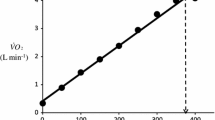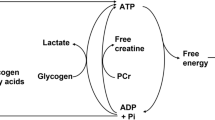Summary
The major determinants of myocardial oxygen consumption (M\(\dot V\)O2) were examined in the isolated, servo-regulated, canine heart in which coronary perfusion pressure, heart rate, ventricular volume and pressure could be individually monitored and controlled. We found that the integral of systolic wall force and the time derivative of systolic force development were major determinants of M\(\dot V\)O2. Net M\(\dot V\)O2, seen in response to increments in contractility (dobutamine) and heart rate, were the result of the relative increments in each of these determinants. Additional studies were performed to assess the heart’s metabolic reserve and aerobic limit (i.e., before the onset of lactate production). We found that with increments in left ventricular work, mediated by increments in filling volume, heart rate, and contractility (dobutamine), myocardial lactate production could be induced, but was dependent on the level of coronary perfusion pressure. When the aerobic limit of the myocardium was exceeded, its performance declined and pulsus alternans appeared.
In patients with cardiomegaly and advanced heart failure given the phosphodiesterase inhibitors enoximone and piroximone we did not observe a rise in M\(\dot V\)O2 or the appearance of lactate production in the majority of patients. When patients with documented idiopathic (dilated) cardiomyopathy and marked heart failure received hemodynamically significant doses of dobutamine alone or in combination with amrinone, there again was no evidence of lactate production or a rise in M\(\dot V\)O2, while a marked improvement in ventricular function was noted. Thus, these agents served to improve the efficiency of the dilated failing heart. Hence we would conclude that in most cases, the dilated failing heart has an adequate metabolic reserve. Its performance, and indeed its efficiency, can be improved with pharmacologic agents having positive inotropic properties without adversely altering myocardial energetics.
Similar content being viewed by others
References
Bittl JA, Balschi JA, Ingwall JS (1987) Contractile failure and high-energy phosphate turnover during hypoxia:31P-NMR surface coil studies in living rat. Circ Res 60:871–878
Alpert NR, Mulieri LA (1982) Increased myothermal economy od isometric force generation in compensated cardiac hypertrophy induced by pulmonary artery constriction in rabbit: A characterization of heat liberation in normal and hypertrophied right ventricular papillary muscle. Circ Res 509:519–500
Weber KT, Janicki JS, Reeves RC, Hefner LL (1997) Myocardial oxygen consumption: the role of wall force and shortening. Am J Physiol 233:H421-H430
Weber KT, Janicki JS (1978) Interdependence of cardiac function, coronary flow and oxygen extraction. Am J Physiol 236:H784-H793
Weber KT, Janicki JS, Fishman AP (1980) Aerobic limit of the heart perfused at constant pressure. Am J Physiol 238:H118-H125
Martin JL, Likoff MJ, Janicki JS, Laskey WK, Hirshfield JW Jr, Weber KT (1984) Myocardial energetics and clinical response to the cardiotonic agent MDL 17,043 in advanced heart failure. J Am Coll Cardiol 4:875–883
Weber KT, Janicki JS, Jain MC (1987) Piroximone (MDL 19,205) in the treatment of unstable and stable chronic cardiac failure. Am Heart J 114:805–813
Sundram P, Reddy K, McElroy PA, Janicki JS, Weber KT (1988) Myocardial energetics and efficiency in patients with idiopathic cardiomyopathy response to dobutamine and amrinone (submitted)
Bing RJ, Hammond MM, Handelsman JC, Powers SR, Spencer FC, Eckenhoff JE, Goodale WT, Hafkenschiel JH, Kety SS (1949) The measurement of coronary blood flow, oxygen consumption and efficiency of the left ventricle in man. Am Heart J 38:1–24
Strauer BE, Beer K, Heitlinger K, Hofling B (1997) Left ventricular wall stress as a primary determinant of myocardial oxygen consumption: comparative studies in patients with normal left ventricular function with pressure and volume overload and with coronary heart disease. Basic Res Cardiol 306–313
Baim DS, Rothman MT, Harrison DC (1982) Simultaneous measurement of coronary venous blood flow and oxygen saturation during transient alterations in myocardial oxygen supply and demand. Am J Cardiol 49:743–752
Janicki JS, Shroff SG, Weber KT (1987) Physiologic response to the inotropic and vasodilator properties of enoximone. Am J Cardiol 60:15C-20C
Amin DK, Shah PK, Hulse S, Shellock FG, Swan HJC (1984) Myocardial metabolic and hemodynamic effects of intravenous MDL 17,043, a new cardiotonic drug, in patients with chronic severe heart failure. Am Heart J 108:1285–1292
Viquerat CE, Kereiakes D, Morris L, Daly PA, Wexman M, Frank P, Parmley WW, Chatterjee K (1985) Alterations in left ventricular function, coronary hemodynamics and myocardial catecholamine balance with MDL 17,043, a new inotropic vasodilator agent, in patients with severe heart failure. JACC 5:326–332
Bennotti J, Grossman W, Braunwald E, Carabello BA (1980) Effects of amrinone on hemodynamics and myocardial metabolism in patients with congestive heart failure from ischemic heart disease. Circulation 62:28–34
Monrad ES, Baim DS, Smith HS, Lanone AS, Braunwald E et al. (1985) Effects of milrinone on coronary hemodynamics and myocardial energetics in patients with congestive heart failure. Circulation 71:972–979
Weber KT, Janicki JS (1987) Chronic cardiac failure. In: Cardiopulmonary exercise testing; physiologic principles and clinical applications. Saunders, Philadelphia, pp 168–196
Covell JW, Braunwald E, Ross John Jr, Sonnenblick EH (1966) Studies on digitalis. XVI. Effects on myocardial oxygen consumption. J Clin Invest 10:1535–1542
Author information
Authors and Affiliations
Rights and permissions
About this article
Cite this article
Weber, K.T., Janicki, J.S. & Sundram, P. Myocardial energetics: experimental and clinical studies to address its determinants and aerobic limit. Basic Res Cardiol 84, 236–246 (1989). https://doi.org/10.1007/BF02650363
Issue Date:
DOI: https://doi.org/10.1007/BF02650363




